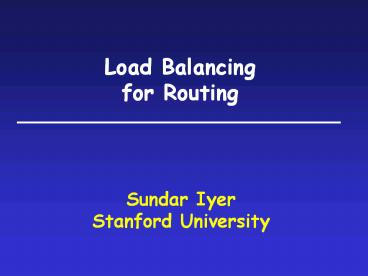The Impact of Load Balancing PowerPoint PPT Presentation
Title: The Impact of Load Balancing
1
Load Balancing for Routing
Sundar IyerStanford University
2
What is Load Balancing? 1Shortest Path Routing
Shortest Path Routing
3
What is Load Balancing? .2Routing using
multiple paths
Load Balancing
4
Will this always work better? No knowledge of
the OD Matrix
Link from (B, A) is more highly loaded than
with ShortestPath Routing
5
Optimal Routing
- MDRP (Gallager)
- Given a network, and a OD traffic matrix D(i,j),
and delays associated with each link, find the
split for each D(i,j,k), from source i to
destination j, along neighbor k, which will
minimize total expected delay. - Optimal Routing cannot be achieved using only
single path routing
6
Approaches to Optimal Routing
- Do not change routing, minimal change to
forwarding - Randomized Routing
- Change forwarding structure only
- Overlay Approach
- Change both routing and forwarding, and calculate
unequal cost multiple paths
7
Randomized Routing
- Valiants Scheme
- Packet goes from (s,d)
- Two phase routing
- Choose intermediate node r at random
- Route from (s,r) and then (r,d) deterministically
- Analysis for Hypercube, Butterfly and Mesh
Networks
8
LBR Routing (Bak)
- Choose r from s at random
- - Can use bad paths, too much delay
- Choose r from s, such that the distance is
not greater than f(s) - F(s) average radius of the network at s
- Can be too weak a restriction (Star Network)
- Can limit capacity to less than the Min cut.
- F(s) does not depend on d
- Incorporate destination
- F(s) dist(s,d) 1 1/max radius
9
Overlay Approach - Present Status
- OSPF and IS-IS
- Multipath routing supported
- But only for shortest equal paths
- This enforces a very severe restriction on the
number of paths available for Load Balancing - IGRP
- Supports all paths which are less thanc
(shortest path)
10
Overlay Approach - Present Status
- Given multiple paths
- There is nothing which enforces the ratio of the
forwarding split - Cisco used to provide
- Flow Caching, which does not enforce any split
- Cisco Express Forwarding
- Per- Destination Load Balancing
- Per- Packet Load Balancing
- Round Robin i.e. equal splits
- Weighted Round Robin is needed to control the
split ratio
11
Overlay Approach
- Link Weight Optimization under equal load sharing
is NP Hard - Equal load sharing can reach near optimal only
for certain topologies - It is possible to convert MDRP into link weights
such that shortest paths to a destination d at
a node are the paths used by MDRP. Wang, Infocom
01 - Caveat The flow split ratio is not known!
12
Questions
- Is it possible to convert MDRP into link weights
such that shortest paths to a destination d at
a node are the paths used by MDRP, such that - the flow split is equal?
- the paths are such that the flow split is in the
inverse ratio of weights. - Answer is probably no to both
13
Basic Multipath Routing Approach
- Try and Approximate MDRP
- Partition MDRP into two parts
- Find multiple loop free paths between (s,d)
- Split each flow along these paths using
heuristics - Heuristics
- Solve difference equations
- For paths with more delay give less weightage
14
Problems in Multipath Routing
- Main Problem
- Avoiding Loops
- 3- node Triangle
- Nodes (A,B,C)
- Each node s has two paths to every destination
d - Example (s,d) and (s,x,d), where x is the other
node. - Packet from A to B, can loop
- A chooses second best path to B (A, C)
- C chooses second best path to B (C, A)
- .. and loop
15
Multipath Routing Protocols
- Distance Vector Extensions
- DASM (Garcia, Zaumen)
- Maintain DAG instead of a tree on each router for
each destination - Maintains an ordering constraint for every
destination, valid for all nodes in the network
to prevent multipath loops - MDVA (Vutukury)
- Loop Free
- Link State Extensions
- MPDA (Vutukury)
- Loop Free

